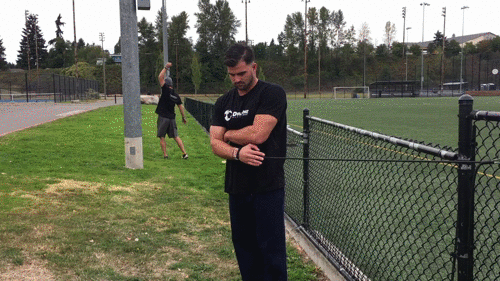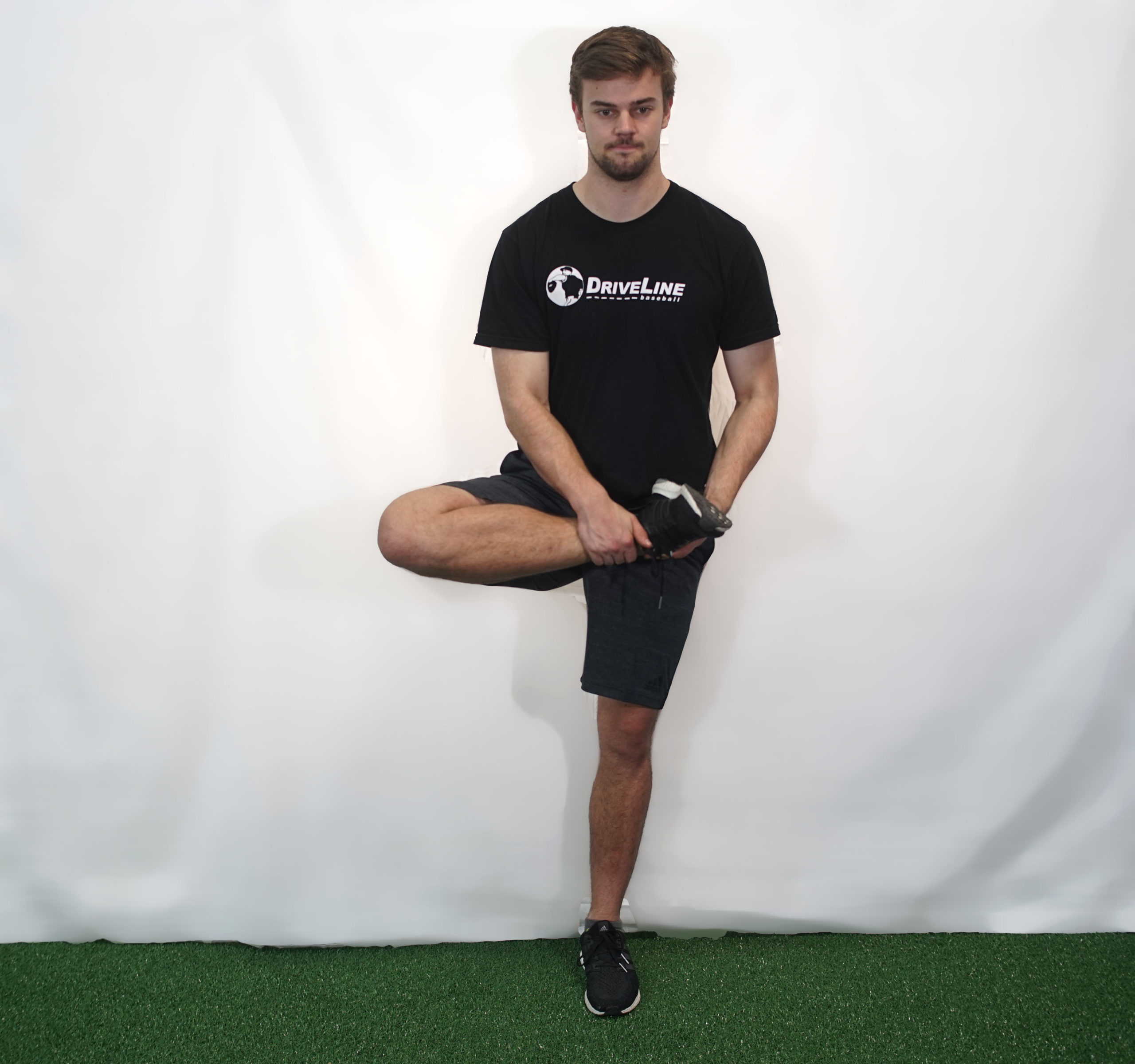Using the Warm-Up for Movement Quality, Conditioning, and Recovery

The warm-up in baseball is an integral part of the throwing and pitching process. It is not simply a mundane obstacle that we must hurdle in order to get to the game or gain access to the bullpen. Likewise, the same can be said about the warm-up in training. It isn’t about getting through the warm-up in order to make it to the training session itself. It is about utilizing the warm-up to our advantage – to get things accomplished.
In both cases the warm-up serves to facilitate the subsequent session, yes, but it can also be used to make valuable change and progress as well. Today we will discuss 3 ways in which the warm-up, in a training context, can be used to accomplish more than just warming-up.
1. The Warm-Up As a Means to Improve Movement Quality
The greatest argument that we can make for taking a stock and stale warm-up and turning it into an efficient mini training session is that – if taken seriously – it is done nearly every day in some fashion, whether it is before a practice, game, or training session. And, you know how the cliche goes, “If it is important, do it every day.”
If we subscribe to this expression, we can see the value in inserting important aspects of performance training into our warm-ups. Not only does this establish a more narrowed focus on improving performance and reducing injuries, but it also creates greater exposure to what’s most important, and movement quality is something that is very important to baseball performance.
Consider the athlete or pitcher that has movement limitations, such as those in the ankles or hips. Rather than simply inserting mobility or soft tissue drills into the training session itself and only exposing the body to this stimuli a handful of times each week, we could instead (or additionally) add ankle and hip mobility drills into the warm-up.
Likewise, core stiffness/trunk stability could be placed in the warm-up for much greater frequency and overall volume as well.
Exercises such as hip mobility drills (e.g. half-kneeling hip flexor mobility) or thoracic spine mobility drills (e.g. 3-point t-spine rotations) could be inserted after the dynamic portion of the warm-up, once blood flow has been redistributed to the skeletal muscles and core body temperature has increased. In this way, the typical conclusion to the warm-up – arm circles, trunk twists, or leg swings – could be replaced with more goal-oriented mobility or stability drills. This adjustment could be made in both the individual and in the team setting as well.
Finally, consider certain athletes that are learning new movements – for example the squat – and are only getting 1-2 exposures to it per week during training sessions. An easy way to give them some more experience with the movement is to add it into the warm-up. But, this isn’t about exposing them to the movement just for the sake of mindless experience. The movement must be as crisp and clean as we can make it. Thus, coaching (or self-coaching) must be diligent and thorough, even if it is “just” a warm-up.
Personally, I refrain from using challenging movements in the warm-up if I plan on one day teaching that movement to my athletes. In this way, I avoid creating bad habits that I will later have to break.
For example, in my experience the Lateral Lunge is often butchered during team warm-ups. Athletes put their hands on the knees, let their chests fall, and half-heartedly shift from side to side. Rather than allowing this to happen for weeks or months on end until I actually introduce proper lateral lunging in the weight room, I will omit it from the warm-up. Once I have taught it in the weight room though, I will then use it liberally during movement prep to reiterate it as a key movement for performance enhancement.
Whether it is a personal limitation, a general restriction observed in many of your athletes as a coach, or key movements that need reiteration, the warm-up is a great way to increase frequency and volume of movement and drills that matter the most.
2. The Warm-Up as Conditioning and General Physical Preparation
The warm-up can also have other desired overall outcomes than just warming-up or movement preparation – it can be an alternate mode to accomplish other forms of training. Let’s discuss a couple of ways in which the warm-up can be a substitute for other methods of training.
For any athlete that struggles with general fitness, the warm-up can be an effective, non-intimidating, and quite possibly an inviting way of building a base of general physical preparation and aerobic fitness.
Before you roll your eyes and ask, “who would actually be challenged by a warm-up?” think about your population.
Do you have any overweight or “out of shape” players on your roster? How about the kid that looks exhausted after throwing just 20 pitches, or after a couple rounds of PFPs? What about the athletes that can swing it and throw it, but that’s about all they are in shape to do? If the answer was yes to any of these questions, then general physical preparation is the solution, and the warm-up can be the vehicle for implementing it.
Mind you, the above situations happen often at the high school level, yes, but they can even occur at the collegiate level when kids walk on or get deals based on their baseball prowess despite a lack of fitness capacity or a bad body.
Rather than simply sticking these athletes in their own group, holding them over later than everyone else to do extra conditioning, and instead of making them jog the warning track or walk on an inclined treadmill, why not try the less invasive and intimidating warm-up?
Now, it shouldn’t be just any old warm-up – i.e. the five-minute show-and-go type of warm-up, or a slow, uninspiring warm-up. It must actually be challenging, and it will most likely need to be extended. For example, try stringing together multiple calisthenic or dynamic-based movements, while interspersing occasional slow, mobility-based movements. In this way, the athlete can get a challenge aerobically without exhausting or fatiguing themselves to a greater extent than desired.
An example would be to perform this “circuit” warm-up three to fives times through:
- Shuffle – 20y and back
- Carioca – 20y and back
- High Knees – 20y and back
- Butt Kicks – 20y and back
- Straight-Leg Kick – 10y and back
- Cradle Walk – 10y and back
- Mini-Band Monster Walk – 10y and back
- Plank Hold – 30s
One last anecdote before you shrug off the practicality or effectiveness of the warm-up as conditioning: I have seen it done and done very well. Not just at high school, but at the professional level too.
3. The Warm-Up as Recovery or Unloading
In the past we have discussed alternate methods for recovery, such as the Recovery Circuit. Another great method for eliciting a recovery-effect is the warm-up.
Personally I am a firm believer in movement as being the greatest key for enhanced recovery. When it comes to my own training, I find that when I take complete off-days in between intense training sessions that I come back to the subsequent training session feeling more sore and beat up.
Whereas, when I include some form of active recovery on my off-day – whether it be a Recovery Circuit, some beach volleyball, or a bike ride – I feel much more ready to perform in the weight room. My athletes generally convey the same feelings during our conversations on the matter. Movement is king when it comes to recovery, and there is science and physiology behind it (although we won’t touch on that today).
Much like the warm-up for conditioning, the warm-up can also be a great recovery tool, especially for the well-conditioned athlete. I say this because we need not worry about well-conditioned athletes getting overly challenged by an extended warm-up.
In terms of energy systems, the goal of the extended warm-up will be somewhat the same for both the conditioned and reconditioned athletes: we will be looking to foster an aerobic training component, not glycolytic. In the case of recovery (unlike conditioning) we aren’t looking to build aerobic fitness, but stimulate a parasympathetic response from the nervous system so that we can enhance recovery. Thus, the the extended warm-up for recovery should not overly fatigue the body. It should be paced well, and should last 15-25 minutes generally.
Not only can we get a parasympathetic response, but we are also facilitating recovery by using movement – all kinds of movement.
The warm-up can also serve as a great unloading session for a team or athlete. Instead of a complete off-day as a way of unloading or deloading the body, we can use the warm-up as an active recovery session. I especially like to do this in-season. For example, I recently utilized the extended warm-up with my high school volleyball squad.
The girl’s volleyball team trains in-season on Monday’s and Wednesday’s. A week or two ago, we had to cancel their Monday session for whatever reason, and on Thursday they had their most significant regular season match of the year. Since they had not done resistance training in over a week, I did not want to induce too much soreness on Thursday by lifting that Wednesday. But, I also did not want to give them an entire week off from training.
We ultimately decided to use an extended warm-up Wednesday afternoon, and allowed that week to be an unloading week. Instead of just taking the week off from training altogether, we were still able to work in quality movements during the warm-up on Wednesday.
Whether it is due to scheduling constraints or quite simply a planned unloading, the extended warm-up can be an effective tool for including active recovery or light physical activity.
***
Many athletes absolutely dread the warm-up. Some programs neglect to utilize it or reinforce its value to their players. In either case, the athletes and/or coaches require a paradigm shift – one that places an emphasis on the warm-up as a tool to improve performance, rather than as an obstacle that must be hurdled to get to the rest of training.
With this value in mind, the warm-up can then be used to improve many aspects of performance, such as movement quality. Likewise, the warm-up can be utilized as an alternate means of accomplishing recovery or unloading.
It is time for all players and coaches to appreciate the value and versatility of the warm-up.
Want to learn more about strength training and how it helps you become a better baseball player? Read all of our articles on the subject here!
Comment section
Add a Comment
You must be logged in to post a comment.





How to Start a Weighted Ball Program Pt. II – Warm Up and Recovery – Pitch Mechanics -
[…] at an exponentially higher risk of injury. There’s a great piece on warm-up / recovery on the Driveline Baseball blog. Here’s a sample of how much time our pitchers spend on each facet of their training […]